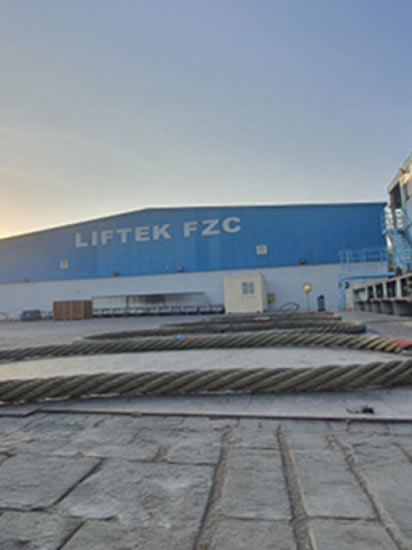In sectors like Energy, maritime, construction, and renewable energy, offshore lifting and rigging are crucial. These procedures, which call for accuracy, safety, and efficiency, entail the handling and movement of large loads in challenging offshore environments.
Innovation and careful adherence to safety rules are more important than ever as offshore projects become more complicated and demanding. The evolution of offshore lifting and rigging is being propelled by the integration of advanced technology, improved materials, and automated systems, which promise better performance and risk management. There are top rigging and lifting equipment suppliers in the UAE you can rely on.
As the best lifting and rigging equipment supplier in the UAE, Liftek offers everything you need for your industrial lifting needs by fusing high-quality products with advanced testing services offered at our top-notch testing facility. Every product we manufacture is tested and certified for durability and safety, and it complies with the latest international standards. This mission is carried out daily by our team of more than 125 committed experts, who have earned DNV certification for ISO 9001 & 14001 and ISO 45001.
The key trends in offshore lifting and rigging for 2025 are explained in this article, along with how businesses may take advantage of these advancements to improve operational efficiency and stay ahead of industry developments.
Trend #1
Smart Load Monitoring & Digitalization
The use of Internet of Things (IoT)-powered smart load monitoring systems is one of the biggest trends in offshore lifting and rigging. These systems provide operators with unmatched accuracy in load monitoring by providing real-time data on tension, weight distribution, and rigging performance.
Preventing overloads, detecting equipment wear and tear early, and enhancing predictive maintenance are just a few benefits of digital load monitoring. Businesses may enhance safety standards, minimize human error, and improve lifting operations by integrating AI-driven analytics. By assisting in the proper scheduling of maintenance, predictive insights help to maximize efficiency and minimize downtime. As one of the top lifting equipment suppliers in Dubai, we ensure that smart load monitoring and digitalization are adapted.
Trend #2
Lightweight & High-Strength Materials
Materials that can withstand extreme environments while maintaining durability and efficiency are crucial for offshore lifting operations. The industry is seeing a move toward high-strength, lightweight materials, including advanced alloys, carbon fiber components, and synthetic slings. Our Liftek lifting technologies are running with high-strength and extremely lightweight materials.
These materials have many advantages, such as improved flexibility, reduced weight, and resistance to corrosion. Businesses can minimize the total weight of lifting equipment, save costs on transportation, and enhance operational efficiency by using lightweight yet strong components. Additionally, these materials' durability ensures a longer service life, which lowers maintenance costs and replacement frequency.

Trend #3
Automation & Remote-Controlled Lifting
Because automation increases precision and reduces human intervention, it is revolutionizing offshore lifting and rigging. Our Liftek lifting technologies are encouraging this to the maximum.
In order to improve efficiency and safety, offshore operations are integrating robotics, automated cranes, and remote-controlled lifting systems. These advanced lifting solutions provide a number of benefits:
In high-risk zones and deepwater operations, where human access is challenging, automated Liftek lifting technologies are very advantageous. Businesses can increase operational reliability and efficiency by investing in robotic and remote-controlled lifting solutions. As one of the best rigging and lifting equipment suppliers in UAE, we ensure the best results.
Trend #4
Sustainable & Eco-Friendly Lifting Solutions
Sustainability is increasingly being prioritized in offshore lifting and rigging due to growing environmental concerns and more strict regulations. Energy-efficient hoists, biodegradable lubricants, and recyclable rigging materials are examples of environmentally friendly lifting solutions that companies are already implementing.
There are several benefits to using sustainable lifting solutions, such as:
The need for sustainable lifting solutions is also being fueled by the growth of offshore renewable energy projects like wind farms. Businesses that make investments in green lifting technology improve their reputation and compliance with evolving industry standards in addition to protecting the environment.
Trend #5
Advanced Safety Regulations & Compliance
In offshore lifting and rigging, safety is still of utmost importance, and regulatory bodies are always updating their regulations to mitigate hazards. Organizations like API, OSHA, and ISO are enforcing more stringent compliance standards for the industry.
Key developments to safety regulations include:
Businesses must spend on appropriate training, certification, and compliance measures in addition to staying ahead of the latest safety regulations. In addition to protecting workers, putting these safety protocols into practice also avoids costly penalties and project delays.
Endnote
Stricter safety regulations, sustainability initiatives, and technological advancements are all driving major change in the offshore lifting and rigging sector. Companies will have an advantage in the evolving market if they use eco-friendly solutions, automation, lightweight materials, and smart load monitoring. As the best lifting and rigging equipment supplier in the UAE, we are making sure to use high-quality structures, including steel wire rope.
Businesses must proactively embrace trends and guarantee adherence to the most recent safety standards if they want to stay ahead in 2025 and beyond. Liftek provides advanced products and expert advice to assist companies in maximizing their lifting solutions. Contact Liftek, one of the top rigging and lifting equipment suppliers in UAE, catering to your offshore project needs.
Since wire rope slings are essential for lifting heavy loads on a regular basis in a variety of industries, such as construction, oil and gas, shipping, and manufacturing, their demand is increasing. Because of this, the industrial lifting equipment market
A crane load test is crucial to ensuring reliability, safety, and compliance with industry requirements. Cranes must be subjected to load testing at predetermined intervals to confirm their lifting capability, stability, and structural integrity under varied load situations.